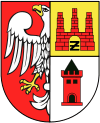Żyrardów
| Żyrardów | |||
|---|---|---|---|
|
Gothic revival church in Żyrardów | |||
| |||
 Żyrardów | |||
| Coordinates: 52°3′N 20°26′E / 52.050°N 20.433°ECoordinates: 52°3′N 20°26′E / 52.050°N 20.433°E | |||
| Country |
| ||
| Voivodeship | Masovian | ||
| County | Żyrardów County | ||
| Gmina | Żyrardów (urban gmina) | ||
| Established | 1830 | ||
| Town rights | 1916 | ||
| Government | |||
| • Mayor | Wojciech Jasiński | ||
| Area | |||
| • Total | 14.35 km2 (5.54 sq mi) | ||
| Population (2006) | |||
| • Total | 41,161 | ||
| • Density | 2,900/km2 (7,400/sq mi) | ||
| Time zone | CET (UTC+1) | ||
| • Summer (DST) | CEST (UTC+2) | ||
| Postal code | 96-300 | ||
| Area code(s) | +48 046 | ||
| Car plates | WZY | ||
| Website |
www | ||
Żyrardów [ʐɨˈrarduf] is a town in central Poland with 41,400 inhabitants (2006). It is situated in the Masovian Voivodship (since 1999); previously, it was in Skierniewice Voivodship (1975–1998) 45 kilometres (28 miles) west of Warsaw. It is the capital of Żyrardów County. Żyrardów is located on the Pisia Gągolina river.
Education
- Szkoła Mistrzostwa Sportowego w Kolarstwie
- Wyższa Szkoła Rozwoju Lokalnego
- Liceum Ogólnokształcące im. Stefana Żeromskiego
- Zespół Szkół Publicznych nr. 7 im. Henryka Sienkiewicza w Żyrardowie
History
Founded by the Łubieński brothers as a textile factory in 1833. One of directors of the factory was French inventor Philippe de Girard (from Lourmarin). The town developed during the 19th century into a significant textile mill town in Poland. In honour of Girard, Ruda Guzowska was renamed to Żyrardów, a toponym derived of the polonised spelling of Girard's name. On September 13, 1939 Germany captured the town. In 1941 they transported Jews into Warsaw ghetto. The town museum is nowadays located in the former palace of owner of factory K. Dittrich.
A sign near the entrance to the town states that it was the only city in Europe, entirely set up for a factory (jedyna w Europie osada fabryczna).
The town was named one of Poland's official national Historic Monuments (Pomnik historii), as designated January 17, 2012. Its listing is maintained by the National Heritage Board of Poland.
Monuments

Most of Żyrardów's monuments are located in the manufacturing area which dates from the 19th and early 20th centuries. It is widely believed that Żyrardów's textile settlement is the only whole urban industrial 19th-century complex to be preserved in Europe.
Famous people
- Feliks Lubienski, landowner who gave the estate and his blessing to his sons to build the very first textile factory
- Feliks Sobański, philanthropist who donated land for the church
- Paweł Hulka-Laskowski, a writer, translator and social activist
- Former Prime Minister Leszek Miller (born in Żyrardów on July 3, 1946), started his professional life as electrician in a local textile factory
International relations
Twin towns — Sister cities
Żyrardów is twinned with:
External links
| Wikimedia Commons has media related to Żyrardów. |
- Official Site of Żyrardów
- A web page of the history of Żyrardów (in Polish)
- Current Population
- Memorial Book of Zyrardow, Amshinov and Viskit
- Jewish Community in Żyrardów on Virtual Shtetl



